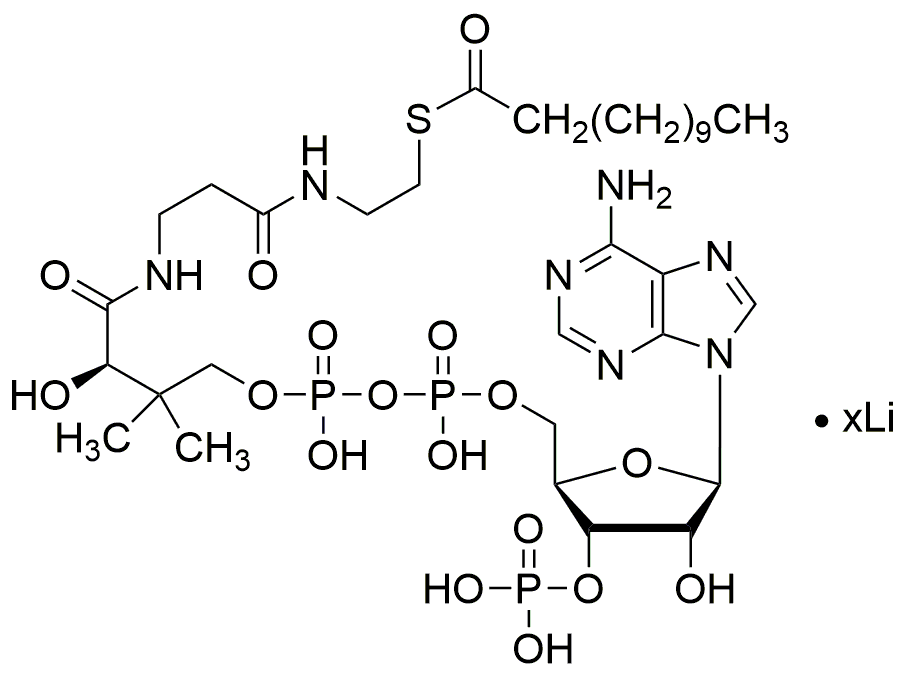Lauroyl coenzyme A lithium salt is widely utilized in research focused on:
- Biochemical Research: This compound plays a crucial role in metabolic studies, particularly in understanding fatty acid metabolism and energy production within cells.
- Drug Development: It serves as a valuable tool in the synthesis of pharmaceutical compounds, aiding researchers in developing new medications targeting metabolic disorders.
- Cell Biology: The compound is used in cell culture studies to investigate cellular processes and signaling pathways, providing insights into cell function and health.
- Cosmetic Formulations: Its properties make it beneficial in the formulation of skincare products, enhancing skin absorption and providing moisturizing effects.
- Food Industry: Lauroyl coenzyme A lithium salt can be explored as a food additive, potentially improving flavor profiles and nutritional content in various food products.
General Information
Properties
Safety and Regulations
Applications
Lauroyl coenzyme A lithium salt is widely utilized in research focused on:
- Biochemical Research: This compound plays a crucial role in metabolic studies, particularly in understanding fatty acid metabolism and energy production within cells.
- Drug Development: It serves as a valuable tool in the synthesis of pharmaceutical compounds, aiding researchers in developing new medications targeting metabolic disorders.
- Cell Biology: The compound is used in cell culture studies to investigate cellular processes and signaling pathways, providing insights into cell function and health.
- Cosmetic Formulations: Its properties make it beneficial in the formulation of skincare products, enhancing skin absorption and providing moisturizing effects.
- Food Industry: Lauroyl coenzyme A lithium salt can be explored as a food additive, potentially improving flavor profiles and nutritional content in various food products.
Documents
Safety Data Sheets (SDS)
The SDS provides comprehensive safety information on handling, storage, and disposal of the product.
Product Specification (PS)
The PS provides a comprehensive breakdown of the product’s properties, including chemical composition, physical state, purity, and storage requirements. It also details acceptable quality ranges and the product's intended applications.
Certificates of Analysis (COA)
Search for Certificates of Analysis (COA) by entering the products Lot Number. Lot and Batch Numbers can be found on a product’s label following the words ‘Lot’ or ‘Batch’.
*Catalog Number
*Lot Number
Certificates Of Origin (COO)
This COO confirms the country where the product was manufactured, and also details the materials and components used in it and whether it is derived from natural, synthetic, or other specific sources. This certificate may be required for customs, trade, and regulatory compliance.
*Catalog Number
*Lot Number
Safety Data Sheets (SDS)
The SDS provides comprehensive safety information on handling, storage, and disposal of the product.
DownloadProduct Specification (PS)
The PS provides a comprehensive breakdown of the product’s properties, including chemical composition, physical state, purity, and storage requirements. It also details acceptable quality ranges and the product's intended applications.
DownloadCertificates of Analysis (COA)
Search for Certificates of Analysis (COA) by entering the products Lot Number. Lot and Batch Numbers can be found on a product’s label following the words ‘Lot’ or ‘Batch’.
*Catalog Number
*Lot Number
Certificates Of Origin (COO)
This COO confirms the country where the product was manufactured, and also details the materials and components used in it and whether it is derived from natural, synthetic, or other specific sources. This certificate may be required for customs, trade, and regulatory compliance.


